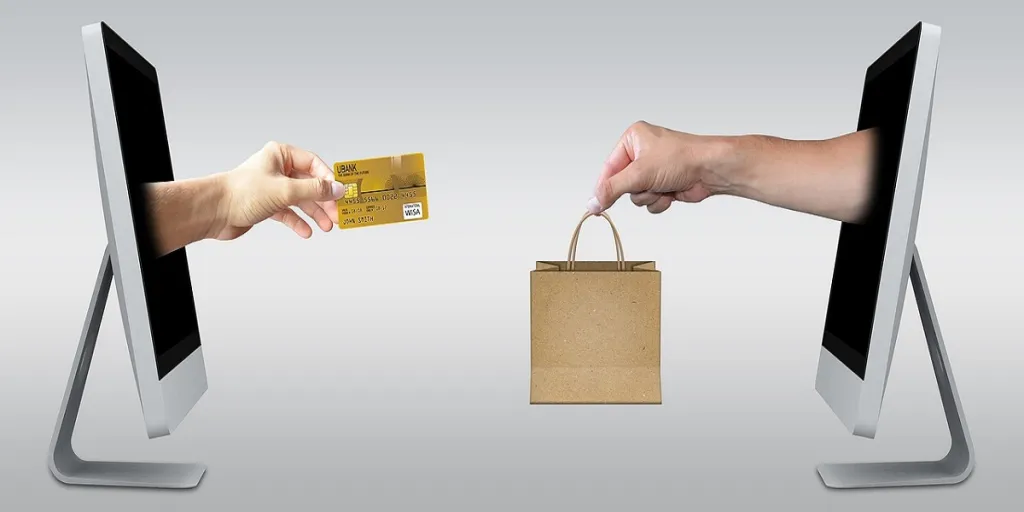Visitors coming to your site are from one of three funnel stages: Top of the Funnel (TOFU), Middle of the Funnel (MOFU), or Bottom of the Funnel (BOFU).
These stages determine, to a great extent, the buying behavior of your visitors. If they’re in the TOFU stage, they’re just learning about your brand and checking out your website. This is the “Awareness” stage.
If they’re from MOFU, they know what you’re selling and are considering prices or alternative products. This is the “Consideration” stage.
However, if they’re at the bottom stage — BOFU — they’re ready to bring out their wallets and shop. This is the “Decision” and “Action” stage.
To increase sales, you should attract more BOFU visitors or get the problem-aware ones to hover from the top and middle stage to the bottom, as that’s where sales happen. But sometimes, potential customers might stay too long at the consideration stage. It’s best to spur them to action before they move on to your competitor.
In this post, we’ll look at seven BOFU tactics for ecommerce to nudge indecisive buyers to checkout. Let’s dive in!
Table of Contents
Use CTAs
Limited time offers
Offer guarantees
Embrace personalization
Use social proof
Use exit-intent pop-ups
Send follow-ups and cart abandonment emails
Wrapping up
1. Use CTAs
Imagine shopping at a retail store with no cashier behind the counter. You’ll probably think the store’s management is unreliable, has crappy customer service, and doesn’t care for customer experience, right?
That’s exactly how it is when online buyers can’t find the checkout button on a website.
A checkout button is one of several different call-to-action (CTA) buttons that guide users toward a specific action you want them to take. This action can be to:
- Add to cart
- Checkout
- View more
- Like or Add to wishlist
- Any other specific action you want visitors to take
For CTA buttons to be effective, they must include an action word, urged towards a specific goal, and strategically placed above the fold so shoppers never miss it.
On Chewy’s home page, for example, different strategically placed CTAs encourage visitors to buy from them or perform some other action leading to checkout.
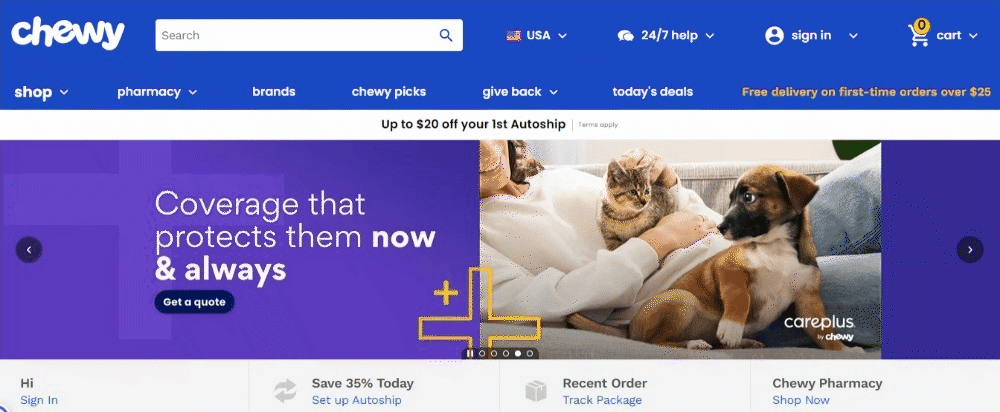
To create effective call-to-actions, think of it outside the scope of succinct words on a button. Depending on the sales campaign, it can be an entire sentence conveying your value proposition. For example, “Spend $200 more to qualify for free shipping!”
Here’s Chewy’s version:
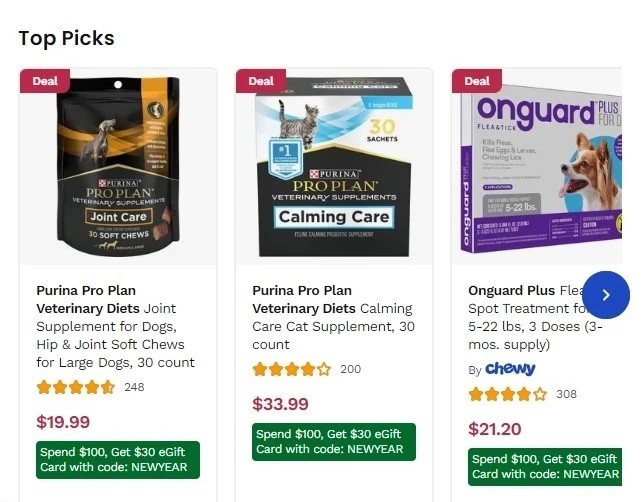
CTAs could also carry a sense of urgency to improve the chances of checkout. For example, “Use code NEW20 to get 20% off your first order. Offer valid today!”
Make the call to action button stand out by using attractive colors and enough white space around it. This will grab shoppers’ attention and encourage them to act.
2. Limited-time offers
Buyers linger for long at the consideration stage because they have yet to find the right motivation to buy. Give them a good offer, and you’ve got yourself a deal. Bonus points if that offer is not on the table for long.
Why? Because then, you’ll trigger their fear of missing out. Some effective tactics to employ are:
Scarcity and urgency
Whenever quality products are scarce, it triggers a sense of urgency that you can use to your advantage. You can leverage this through:
- Countdown timers: Put a countdown timer on your website or sales page to highlight the limited timeframe of an offer. This will encourage immediate action.
- Limited stock: Make it clear that there’s a limited quantity of the product or service at the special price. This increases the sense of scarcity and motivates buyers to act quickly.
- Flash sales: Provide significant discounts on your website or social media page for a short time. The surprise element creates excitement and encourages impulsive buying.
Highlighting value and exclusivity
Another way to reinforce limited-time offers for hesitant buyers is to amplify the exclusivity of a limited-access product. This builds the perception of value, inciting them to take action.
Some effective approaches include:
- Offering bundle discounts: Combine complementary products or services and put them on discounts for limited-time offers. This’ll add value and motivate buyers to spend more.
- Early bird access: Offer exclusive perks or early access to new product releases for those who buy during the limited time period. This creates an air of exclusivity and rewards prompt action.
Australian beddings and sheets company, eCoy, incorporated an early bird or presales strategy for their Bamboo Quilt marketing campaign.

They offered free delivery and a 20% early bird discount for this item driving the value up. Like eCoy, including free shipping or bonus gifts with purchases made during the limited-time offer sweetens the deal and makes it more enticing.
Although limited-time nudges are effective BOFU tactics for ecommerce, buyers can only convert when they recognize that acting fast serves their self-interest. Therefore, anchor this strategy with real benefits, not just pressure.
3. Offer guarantees
Guarantees act as a safety net for customers. It instills trust and confidence, encouraging them to convert. But first-time shoppers are super conscious of objections or obstacles during checkout. Hence, it’s your job to help overcome them.
Sometimes, these objections have to do with a perceived risk in site security. Survey statistics compiled by Convertcart show 31% of online buyers value safety over convenience, and another 35% will, in fact, dump their carts in the absence of trust badges.
With the rise in phishing attacks, and credit or debit card fraud, customers need assurance that their information is safe during checkout. You can increase trust and guarantee security by:
- Ensuring your site is SSL-secured to convey that your customers’ information is protected.
- Using trust badges like Digicert, McAfee and Verisign on your website to put their minds at ease.
- Using MasterCard, Visa, American Express, and PayPal for faster payment processing.
Buyer apprehension could also stem from a lack of trust in product quality or return policy systems. In that case, offer strong guarantees that signal high-end service standards.
You may offer one or more guarantees depending on your specific offerings and target audience. These can include: money-back guarantees, best-price guarantees, 100% satisfaction, lifetime guarantees, return and refund guarantees, etc., each offering varying levels of risk and reward.
ThirdLove, a women’s undergarments company, offers “perfect fit” promises — a guarantee that entitles buyers to free exchanges and returns for up to 60 days of wear in their products.
While Thirdlove’s form of guarantee might not work for all products, the key is to ensure the terms of your guarantee are transparent and easily accessible to customers. Outline conditions, timeframes, and any limitations to avoid confusion or disappointment.
For instance, Everlane’s return policy states clearly on its website that the timeframe for returning unworn items is 30 days.
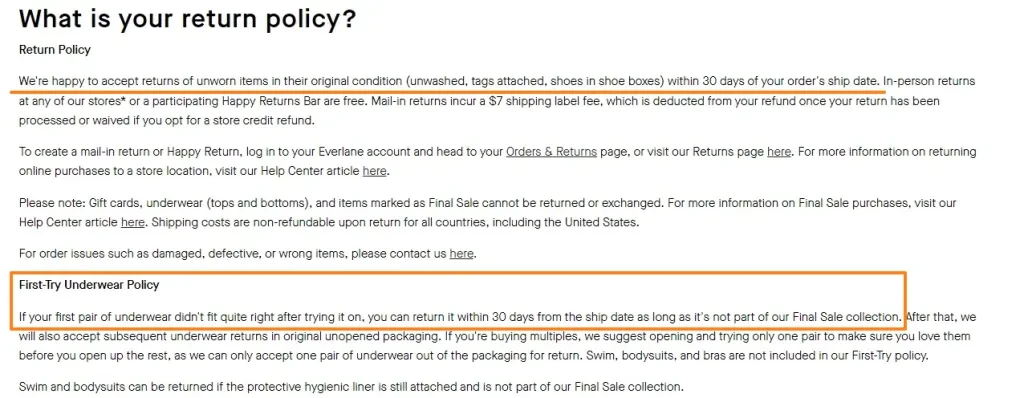
Subtly highlight your guarantees throughout each stage of the shopping process leading to checkout, so it remains top of mind.
A well-defined guarantee can help you attract more customers, boost sales, and enhance your brand’s reputation.
4. Embrace personalization
Have you ever seen an” If you like this, you might like this” pop-up on your screen or a curated products section “just for you” when shopping online? That’s ecommerce personalization at work. It’s a strategy that tailors online shopping experiences to individual customers.
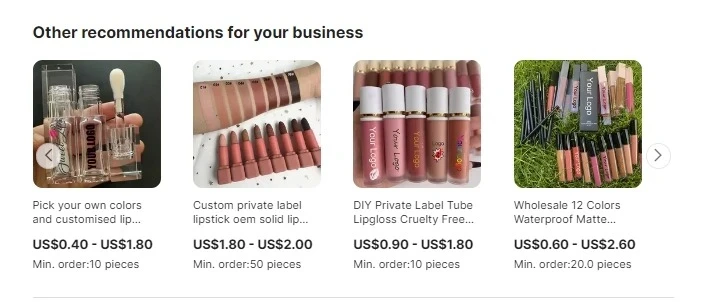
Ecommerce personalization allows you to deliver relevant content, product recommendations and offers based on customers’ preferences, previous interactions with your site, and demographics.
Personalized content is key to increasing average order value (AOV), conversion rates, and customer satisfaction. Here are a few ways to personalize ecommerce content for the bottom of the funnel.
Implement it into your email drip campaign
Email personalization goes beyond addressing recipients by name. It can include dynamic content based on buyer’s behavior, preferences, and segmentation.
For instance, you can send personalized product recommendations via email to a customer who created a wishlist or abandoned their cart.
This is a common yet effective BOFU tactic amongst ecommerce retailers. According to research, nearly eight out of ten consumers prefer to buy from brands that recognize them by name, recommend options based on past purchases, or know their purchase history.
If done well, this targeted approach can rejig buyers’ interests to complete their purchase on your site.
Personalize landing page content based on ads
When the content a potential customer sees on a landing page reflects what was advertised to them, it creates a more seamless online shopping experience.
For example, if an ad promotes a sale on running shoes, the landing page should showcase those same running shoe deals.
The goal is to ensure relevancy between ad messaging and landing page content for each customer. This consistency primes customers to purchase by building on the intent established in the earlier ad interaction.
Recommend products based on site interactions
Your ecommerce store can provide a personalized shopping experience by tracking each customer’s behavior and recommending relevant products. Analyze what products your visitors view, buy, and search for on your website. These interactions can offer insight into their preferences.
Then, serve up suggestions tailored to each user based on what they have shown interest in. If someone tends to view fitness gear, recommend more related activewear and equipment.
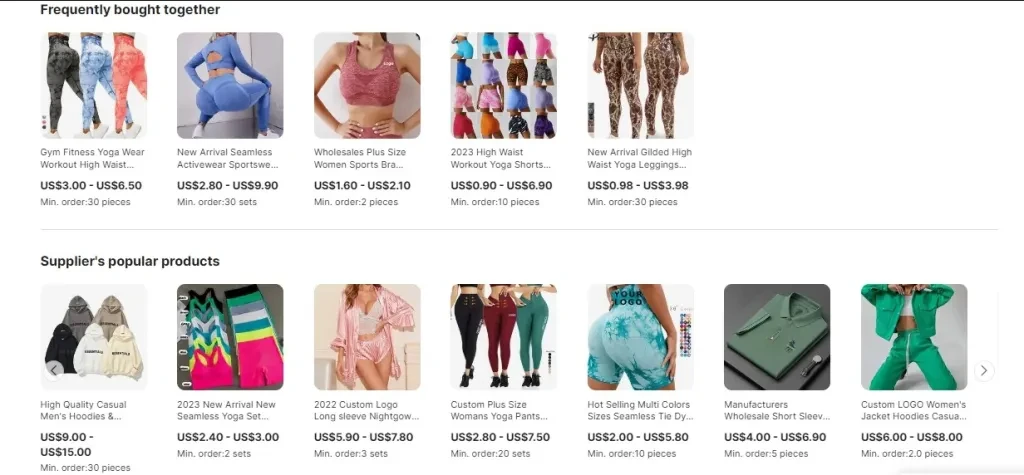
When product recommendations feel personalized rather than generic, customers feel valued. Thus leading to improved satisfaction, additional purchases, and increased revenue.
5. Use social proof
Social proof in ecommerce involves using testimonials, reviews, and online feedback as marketing material to influence buyers’ decisions.
A popular bakery will likely have good foot traffic and a solid customer base. Why? Because this gives the impression that their products are high quality; otherwise, why would so many people patronize them?
They also wouldn’t have been that popular if Mary hadn’t told Beth and Beth hadn’t told Martha. We can conclude that word-of-mouth marketing, also known as social proof, was a significant reason for the bakery’s success.
Similarly, social proof is necessary in ecommerce to convince hesitant buyers considering your products. You can incorporate this tactic at the BOFU stage by:
Using user-generated content in your retargeted ads. Doing this will enable you to convince visitors who engaged with your brand content or a similar product somewhere in their buyer journey.
Including customer reviews and ratings on your site, such that potential buyers see them before checkout.
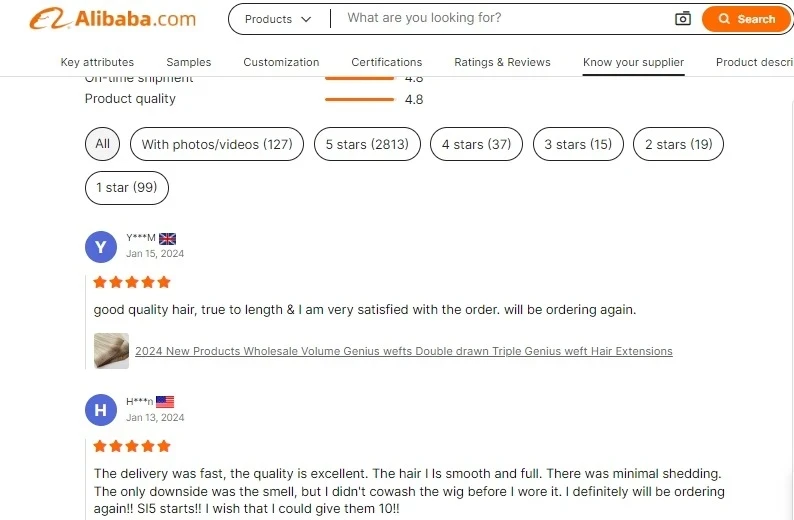
Repurposing customer testimonials as product copy in your cart abandonment emails. You can get creative and use a one-line review in an email subject line. For example: “Obsessed with this jacket!” – Taylor, Denver.
Some brands like BOSE go heavy on social proofs and craft an entire email body around their customer testimonials.

With this tactic, you can leverage your existing goodwill with your customers, thereby conquering the last obstacle on-the-fence buyers face – fear.
6. Use exit-intent pop-ups
Exit-intent pop-ups target shoppers who seem ready to leave your site without making a purchase. As the cursor moves to close the page, these pop-ups appear with special offers to capture last-minute sales. They serve as a final lifeline for capturing abandoned carts by reminding customers of discounts or free shipping they would miss out on.
ThirdLove employs this tactic, offering a catchy offer of 15% off, as soon as a visitor attempts to leave the page.
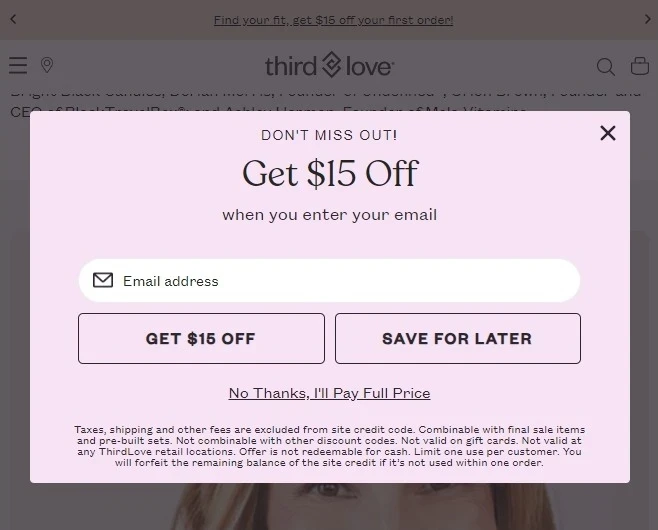
If you target exit-intent pop-ups properly, they give you a final chance to capture abandoning visitors before they leave your website. They show that you value their business and want to secure the sale.
If you use overly aggressive tactics, visitors may be irritated. Well-crafted exit offers persuade shoppers to stay and convert at the last minute.
7. Send follow-ups and cart abandonment emails
Don’t let shopping carts go cold and sales fall by the wayside. Send timely and relevant follow-up emails when a customer doesn’t complete checkout. Use smart segmentation to track shopper behavior and tailor messages to each stage.
Early abandonment emails might highlight popular products. Later ones may promote discounts or gently remind them items remain in the cart, like this example below.

Follow a nurturing sequence, not an assault. The goal is to provide value around their interest areas to gently win back their business.
Useful recommendations, exclusive deals, and friendly reminders bring cart abandoners back into your funnel for conversion success. Just avoid being pushy or overbearing.
Wrapping up
Some shoppers know what they want to buy but need an extra nudge to complete the purchase. Ecommerce BOFU tactics like social proof reviews and well-timed special offers speak directly to these ready-to-buy visitors, encouraging them to take action.
The goal is to guide visitors down the final funnel into purchase smoothly. Prompt the right buyers at the right time, and your revenue will thank you.
